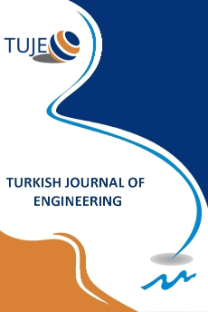ANALYSIS OF THE TRACE ELEMENT CONTENT OF GRAPE MOLASSES PRODUCED BY TRADITIONAL MEANS
ANALYSIS OF THE TRACE ELEMENT CONTENT OF GRAPE MOLASSES PRODUCED BY TRADITIONAL MEANS
___
- Akbulut. M.. & Özcan. M. M. (2008). "Some physical. chemical. and rheological properties of sweet sorghum (Sorghum Bicolor (L) Moench) Pekmez (Molasses)." International Journal of Food Properties. 11(1). 79-91.
- Artık, N., & Velioğlu, S. (1993). Research on Determining the Compliance of Some Molasses Samples to the Standard.. Standard, 32, 51-54.
- Assis, R.A.D., Küchler, I.L., Miekeley, N., & Silveira, C.L.P.D. (2008). Trace elements and sodium in grape juice: nutritional and toxicological aspects. Química Nova, 31(8), 1948-1952.
- Chatterjee. J.. & Chatterjee. C. (2000). "Phytotoxicity of cobalt. chromium and copper in cauliflower." Environmental pollution. 109(1). 69-74.
- Cherfi. A.. Achour. M.. Cherfi. M.. Otmani. S.. & Morsli. A. (2015). "Health risk assessment of heavy metals through consumption of vegetables irrigated with reclaimed urban wastewater in Algeria." Process safety and environmental protection. 98. 245-252.
- Demirci, S.K.M. (2006). Effects of storage time and condition on mineral contents of grape pekmez produced by vacuum and classical methods. Tekirdağ Ziraat Fakültesi Dergisi, 3(1), 1-7.
- Demirözü. B.. Sökmen. M.. Uçak. A.. Yilmaz. H.. & Gülderen. Ş. (2002). "Variation of copper. iron. and zinc levels in pekmez products." Bulletin of environmental contamination and toxicology. 69(3). 330-334.
- Fan. Y.. Li. H.. Xue. Z.. Zhang. Q.. & Cheng. F. (2017). "Accumulation characteristics and potential risk of heavy metals in soil-vegetable system under greenhouse cultivation condition in Northern China." Ecological engineering. 102. 367-373.
- ICH. (1996). Guidance for Industry: Validation of Analytical Procedures: Definitions and Terminology. Q2A. Geneva Switzerland.
- Karababa. E.. & Develi Isikli. N. (2005). "Pekmez: A traditional concentrated fruit product." Food reviews international. 21(4). 357-366.
- Nabulo. G.. Oryem-Origa. H.. & Diamond. M. (2006). "Assessment of lead. cadmium. and zinc contamination of roadside soils. surface films. and vegetables in Kampala City. Uganda." Environmental Research. 101(1). 42-52.
- Ohki. A.. Nakajima. T.. Hirakawa. S.. Hayashi. K.. & Takanashi. H. (2016). "A simple method of the recovery of selenium from food samples for the determination by ICP-MS." Microchemical Journal. 124. 693-698.
- Petkova. N.. Petrova. I.. Ivanov. I.. Mihov. R.. Hadjikinova. R.. Ognyanov. M.. & Nikolova. V. (2017). "Nutritional and antioxidant potential of carob (Ceratonia siliqua) flour and evaluation of functional properties of its polysaccharide fraction." Journal of Pharmaceutical Sciences and Research. 9(11). 2189- 2195.
- Quinaia. S.P.. & Nobrega. J.A. (1999). "Direct determination of chromium in gelatine by graphite furnace atomic absorption spectrophotometry." Food chemistry. 64(3). 429-433.
- Segura-Muñoz. S.I.. da Silva Oliveira. A.. Nikaido. M.. Trevilato. T.M.B.. Bocio. A.. Takayanagui. A.M.M.. & Domingo. J.L. (2006). "Metal levels in sugar cane (Saccharum spp.) samples from an area under the influence of a municipal landfill and a medical waste treatment system in Brazil." Environment International. 32(1). 52-57.
- Tarakçı, Z., & Küçüköner, E. (2003). Investigation of Some Mineral and Heavy Metal Content of Various Herbal Additive Dairy Products. III. Food Engineering Congress, (2-3 October), Ankara, 448-449.
- Tosun. I.. & Ustun. N.S. (2003). "Nonenzymic browning during storage of white hard grape pekmez (Zile pekmezi)." Food Chemistry. 80(4). 441-443.
- TFC. (2017). Turkish Food Codex Communiqué on Grape Molasses (Communiqué No: 2017/8).
- Viran. R.. Erkoç. F.Ü.. Polat. H.. & Koçak. O. (2003). "Investigation of acute toxicity of deltamethrin on guppies (Poecilia reticulata)." Ecotoxicology and environmental safety. 55(1). 82-85.
- Xia. J.. Xu. J.. Hu. L.. & Liu. X. (2016). "Enhanced poly (L-malic acid) production from pretreated cane molasses by Aureobasidium pullulans in fed-batch fermentation." Preparative Biochemistry and Biotechnology. 46(8). 798-802.
- Yıldız. E.. Saçmacı. Ş.. Kartal. Ş.. & Saçmacı. M. (2016). "A new chelating reagent and application for coprecipitation of some metals in food samples by FAAS." Food chemistry. 194. 143-148.
- Zhao. Q.. Wang. Y.. Cao. Y.. Chen. A.. Ren. M.. Ge. Y.. ... & Ruan. L. (2014). "Potential health risks of heavy metals in cultivated topsoil and grain. including correlations with human primary liver. lung and gastric cancer. in Anhui province. Eastern China." Science of the Total Environment. 470. 340-347.
- Zhang. Y.Y.. Bu. Y.F.. & Liu. J.Z. (2015). "Production of L-ornithine from sucrose and molasses by recombinant Corynebacterium glutamicum." Folia microbiologica. 60(5). 393-398.
- Zhang. Y.. Ji. X.. Ku. T.. Li. G.. & Sang. N. (2016). "Heavy metals bound to fine particulate matter from northern China induce season-dependent health risks: a study based on myocardial toxicity." Environmental pollution. 216. 380-390.
- ISSN: 2587-1366
- Yayın Aralığı: 4
- Başlangıç: 2017
- Yayıncı: Mersin Uüniversitesi
DEVELOPMENT OF A NEW APPROACH TO MEMBRANE BIOREACTOR TECHNOLOGY: ENHANCED QUORUM QUENCHING ACTIVITY
İsmail Koyuncu, Tülay Ergön Can, Börte Köse Mutlu, Meltem AĞTAŞ, Chung Hak Lee
HACER SİBEL KARAPINAR, Fevzi KILIÇEL
A NEW METHOD FOR THE MEASUREMENT OF SOFT MATERIAL THICKNESS
Mustafa Tahsin Guler, smail Bilican
ANALYSIS OF THE TRACE ELEMENT CONTENT OF GRAPE MOLASSES PRODUCED BY TRADITIONAL MEANS
Hacer Sibel Karapınar, Fevzi Kılıçel
WASTE MINERAL OILS RE-REFINING WITH PHYSICOCHEMICAL METHODS
Tülay ERGÖN CAN, Börte KÖSE MUTLU, Meltem AĞTAŞ, Chung Hak LEE, İSMAİL KOYUNCU
DETERMINATION OF SOUND TRANSMISSION COEFFICIENT OF GYPSUM PARTITION WALLS INSULATED BY CELLUBOR™
Abdulkerim Ilgün, Ahmad Javid Zia
LOW-POWER DYNAMIC COMPARATOR WITH HIGH PRECISION FOR SAR ADC
